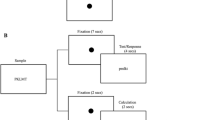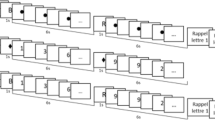Abstract
The present study analyzed the role of phonological and executive components of working memory in the borrow operation in complex subtractions (Experiments 1 and 2) and in the carry operation in complex multiplications (Experiments 3 and 4). The number of carry and borrow operations as well as the value of the carry were manipulated. Results indicated that both the number of carry/borrow operations and the value of the carry increased problem difficulty, resulting in higher reliance on phonological and executive working-memory components. Present results are compared with those obtained for the carry operation in complex addition and are further discussed in the broader framework of working-memory functions.








Similar content being viewed by others
Notes
Recently, a first attempt in this direction was made in an unpublished study in our lab. Complex multiplications (e.g., 16×8) were presented visually on which participants had to provide an oral response as soon as they had calculated the product. Phonological WM was loaded by presenting a five-letter string which participants had to repeat subvocally while calculating. An effect of phonological WM load was observed on accuracies but not on latencies. More specifically, accuracies tended to be lower under phonological WM load than in the control condition [t(19)=1.56; p=0.07; one-tailed]. Future research may elaborate on this issue.
References
Ashcraft, M. H. (1992). Cognitive arithmetic: a review of data and theory. Cognition, 44, 75–106
Ashcraft, M. H. (1995). Cognitive psychology and simple arithmetic: a review and summary of new directions. Mathematical Cognition, 1, 3–34
Ashcraft, M. H., & Battaglia, J. (1978). Cognitive arithmetic: evidence for retrieval and decision processes in mental addition. Journal of Experimental Psychology: Human Learning and Memory, 4, 527–538
Ashcraft, M. H., & Faust, M. W. (1994). Mathematics anxiety and mental arithmetic performance: an exploratory investigation. Cognition and Emotion, 8, 97–125
Ashcraft, M. H., & Kirk, E. P. (2001). The relationships among working memory, math anxiety, and performance. Journal of Experimental Psychology: General, 130, 224–237
Ashcraft, M. H., & Stazyck, E. K. H. (1981). Mental addition: a test of three verification models. Memory & Cognition, 9, 185–196
Ashcraft, M. H., Donley, R. D., Halas, M. A., & Vakali, M. (1992). Working memory, automaticity, and problem difficulty. In J. I. D. Campbell (Ed.), The nature and origins of mathematical skills (pp. 301–329). Amsterdam: Elsevier
Baddeley, A. D. (1986). Working memory. Oxford: Oxford University Press
Baddeley, A. D. (1992). Is working memory working? The fifteenth Bartlett Lecture. Quarterly Journal of Experimental Psychology, 44, 1–31
Baddeley, A. D., & Hitch, G. J. (1974). Working memory. In G. Bower (Ed.). The Psychology of Learning and Motivation (vol 8, pp. 47–90). New York: Academic
Baddeley, A. D., & Lieberman, K. (1980). Spatial working memory. In R. S. Nickerson (Ed.), Attention and performance VIII (pp. 521–539). Hillsdale: Erlbaum
Baddeley, A. D., & Logie, R. H. (1992). Auditory imagery and working memory. In D. Reisberg (Ed.), Auditory imagery (pp. 179–197). Hillsdale: Erlbaum
Baddeley, A. D., & Logie, R. H. (1999). Working memory: the multi-component model. In A. Miyake & P. Shah (Eds.), Models of working memory: mechanisms of active maintenance and executive control (pp. 28–61). New York: Cambridge University Press
Baddeley, A. D., Thomson, N., & Buchanan, M. (1975). Word length and the structure of short term memory. Journal of Verbal Learning & Verbal Behaviour, 14, 575–589
Barrouillet, P., Bernardin, S., & Camos, V. (2004). Time constraints and resource sharing in adults’ working memory spans. Journal of Experimental Psychology: General, 133, 83–100
Brown, J. S., & Burton, R. R. (1978). Diagnostic models for procedural bugs in basic mathematical skills. Cognitive Science, 2, 155–192
Butterworth, B., Zorzi, M., Girelli, L., & Jonckheere, A. R. (2001). Storage and retrieval of addition facts: the role of number comparison. The Quarterly Journal of Experimental Psychology, 54A, 1005–1029.
Campbell, J. I. D., & Xue, Q. (2001). Cognitive arithmetic across cultures. Journal of Experimental Psychology: General, 130, 299–315
Cooney, J. B., Swanson, H. L., & Ladd, S. F. (1988). Acquisition of mental multiplication skill; evidence for the transition between counting and retrieval strategies. Cognition and Instruction, 5, 323–345
Dansereau, D. F., & Gregg, L. W. (1966). An information processing analysis of mental multiplication. Psychonomic Science, 6, 71–72
De Rammelaere, S., Stuyven, E., & Vandierendonck, A. (1999). The contribution of working memory recourses in the verification of simple arithmetic sums. Psychological Research, 62, 72–77
De Rammelaere, S., Stuyven, E., & Vandierendonck, A. (2001). Verifying simple arithmetic sums and products: are the phonological loop and the central executive involved? Memory & Cognition, 29, 267–273
De Rammelaere, S., & Vandierendonck, A. (2001). Are executive processes used to solve simple mental arithmetic production tasks? Current Psychology Letters: Behaviour, Brain & Cognition, 2, 79–82
DeStefano, D., & LeFevre, J.-A. (2004). The role of working memory in mental arithmetic. European Journal of Cognitive Psychology, 16, 353–386
Farmer, E. W., Berman, J. V. F., & Fletcher, Y. L. (1986). Evidence for a visuo-spatial scratch-pad in working memory. Quarterly Journal of Experimental Psychology, 38A, 675–688
Faust, M. W., Ashcraft, M. H., & Fleck, D. E. (1996). Mathematics anxiety effects in simple and complex addition. Mathematical Cognition, 2, 25–62
Fürst, A. J., & Hitch, G. J. (2000). Separate roles for executive and phonological components of working memory in mental arithmetic. Memory & Cognition, 28, 774–782
Geary, D. C. (1994). Children’s mathematical development: research and practical applications. Washington DC: American Psychological Association
Geary, D. C. (1996). The problem-size effect in mental addition: developmental and cross-national trends. Mathematical Cognition, 2, 63–93
Geary, D. C., Frensch, P. A., & Wiley, J. G. (1993). Simple and complex mental subtraction: strategy choice and speed-of-processing differences in younger and older adults. Psychology and aging, 8, 242–256
Geary, D. C., & Widaman, K. F. (1987). Individual differences in cognitive arithmetic. Journal of Experimental Psychology: General, 116, 154–171
Geary, D. C., Widaman, K. F., & Little, T. D. (1986). Cognitive addition and multiplication: evidence for a single memory network. Memory & Cognition, 14, 478–487
Geary, D. C., Frensch, P. A., & Wiley, J. G. (1993). Simple and complex mental subtraction: strategy choice and speed-of-processing differences in younger and older adults. Psychology and Aging, 8, 242–256
Gilhooly, K. J., Logie, R. H., Wetherick, N., & Wynn, V. (1993). Working memory and strategies in syllogistic reasoning tasks. Memory & Cognition, 21, 115–124
Hecht, S. A. (2002). Counting on working memory in simple arithmetic when counting is used for problem solving. Memory and Cognition, 30, 447–455
Hitch, G. J. (1978). The role of short-term working memory in mental arithmetic. Cognitive Psychology, 10, 302–323
Hope, J. A., & Sherill, J. M. (1987). Characteristics of skilled and unskilled calculators. Journal of Research in Mathematics Education, 18, 98–111
Lee, K.-M., & Kang, S.-Y. (2002). Arithmetic operation and working memory: differential suppression in dual tasks. Cognition, 83, B63–B68
Lemaire, P., Abdi, H., & Fayol, M. (1996). The role of working memory resources in simple cognitive arithmetic. European Journal of Cognitive Psychology, 8, 73–103
Logie, R. H. (1986). Visuo-spatial processing in working memory. Quarterly Journal of Experimental Psychology, 38A, 229–247
Logie, R. H. (1989). Characteristics of visual short-term memory. European Journal of Cognitive Psychology, 1, 275–284
Logie, R. H. (1991). Visuo-spatial short-term memory: visual working memory or visual buffer? In C. Cornoldi & M. A. Mc Daniel (Eds.), Imagery and cognition (pp. 77–102). Berlin Heidelberg New York: Springer
Logie, R. H. (1993). Working memory in everyday cognition. In G. M. Davies & R. H. Logie (Eds.), Memory in everyday life (pp. 173–218). Amsterdam: Elsevier
Logie, R. H., & Baddeley, A. D. (1987). Cognitive processes in counting. Journal of Experimental Psychology: Learning, Memory, & Cognition, 2, 310–326
Logie, R. H., Gilhooly, K. J., & Wynn, V. (1994). Counting on working memory in arithmetic problem solving. Memory & Cognition, 22, 395–410
Miyake, A., & Shah, P. (1999). Models of working memory: mechanisms of active maintenance and executive control. Cambridge: Cambridge University Press
Noël, M.-P., Désert, M., Aubrun, A., & Seron, X. (2001). Involvement of short-term memory in complex mental calculation. Memory & Cognition, 29, 34–42
Salamé, P., & Baddeley, A. D. (1982). Disruption of short-term memory by unattended speech: implications for the structure of working memory. Journal of Verbal Learning and Verbal Behavior, 21, 150–164
Sandrini, M., Miozzo, A., Cotelli, M., & Cappa, S.F. (2003). The residual capacities of a patient with severe aphasia: Evidence for a selective deficit of subtraction procedures. Cortex, 39, 85–96
Seitz, K., & Schumann-Hengsteler, R. (2000). Mental multiplication and working memory. European Journal of Cognitive Psychology, 12, 552–570
Seitz, K., & Schumann-Hengsteler, R. (2002). Phonological loop and central executive processes in mental addition and multiplication. Psychologische Beiträge, 44, 275–302
Seyler, D.J., Kirk, E.P., & Ashcraft, M.H. (2003). Elementary subtraction. Journal of Experimental Psychology: Learning, Memory, & Cognition, 29, 1339–1352
Siegler, R. S. (1988). Strategy choice procedures and the development of multiplication skill. Journal of Experimental Psychology: General, 117, 258–275
Szmalec, A., Vandierendonck, A., & Kemps, E. (2005). Response selection involves executive control: evidence from the selective interference paradigm. Memory & Cognition, 33, 531–541
Trbovich, P. L., & LeFevre, J. A. (2003). Phonological and visual working memory in mental addition. Memory & Cognition, 31, 738–745
Widaman, K. F., Geary, D. C., Cormier, O., & Little, T. D. (1989). A componential model of mental addition. Journal of Experimen tal Psychology: Learning, Memory, & Cognition, 15, 898–919
Acknowledgements
This research was supported by grant no. 011D07803 of the Special Research Fund of Ghent University to the first author and grant no. 10251101 of the Special Research Fund of Ghent University to the second author. Correspondence concerning this article should be addressed to Ineke Imbo, Department of Experimental Psychology, Ghent University, Henri Dunantlaan 2, 9000 B-Ghent, Belgium (Ineke.Imbo@UGent.be).
Author information
Authors and Affiliations
Corresponding author
Rights and permissions
About this article
Cite this article
Imbo, I., Vandierendonck, A. & Vergauwe, E. The role of working memory in carrying and borrowing. Psychological Research 71, 467–483 (2007). https://doi.org/10.1007/s00426-006-0044-8
Received:
Accepted:
Published:
Issue Date:
DOI: https://doi.org/10.1007/s00426-006-0044-8




